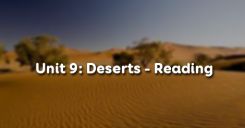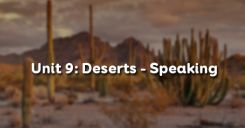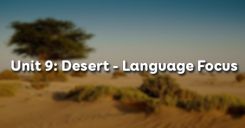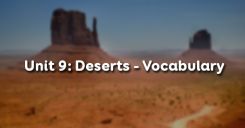Bài học Unit 9 Deserts phần Listening giúp các em hiểu thêm về cách để có một cuộc sống tốt hơn ở vùng sa mạc. Qua bài học, các em được luyện tập kỹ năng nghe để tìm thông tin chi tiết và bổ sung phần thiếu của nội dung cần tìm.
Tóm tắt bài
1. Before You Listen Unit 9 Lớp 12
Work in pairs. Ask and answer the following questions.
(Làm việc theo cặp. Hỏi và trả lời các câu hỏi sau.)
1. What is a desert? (Sa mạc là gì?)
2. How is a desert formed? (Sa mạc được hình thành như thế nào?)
3. Can human beings make a desert? Why/Why not? (Con người có thể tạo ra sa mạc không? Tại sao?)
Guide to answer
1. A desert is a large area of land where it is always very hot and dry and there is a lot of sand.
2. A desert can be formed by various causes, the major of which is global climatic change. The second cause is the degradation of land by humans such as poor land management and poor water management, and at present the deforestation.
3. Yes. They can make a desert by the degradation of land, and by the deforestation or overcultivation and incorrect irrigation methods.
2. While You Listen Unit 9 Lớp 12
2.1. Unit 9 Listening Task 1
You will hear an expert talking about deserts, what they are and how they are formed. Listen to his talk and decide whether the statements are true (T) or false (F).
(Em sẽ nghe một chuyên gia nói chuyện về sa mạc, sa mạc là gì và chúng được hình thành như thế nào. Lắng nghe bài nói của ông ấy và chọn câu đúng hoặc sai)
- In a desert, everything is hard.
- Only trees with hard needles can grow in deserts.
- Space seems to have no limit in the desert.
- Nature causes the change in the size and location of the world’s deserts.
- Rabbits are one of the agents that help make deserts in Australia.
Guide to answer
- In a desert, everything is hard. (T)
- Only trees with hard needles can grow in deserts. (F) ---> Many plants such as trees with hard needles can grow in deserts.
- Space seems to have no limit in the desert. (T)
- Nature causes the change in the size and location of the world’s deserts. (F) ---> Human and nature
- Rabbits are one of the agents that help make deserts in Australia. (T)
2.2. Unit 9 Listening Task 2
Listen again and answer the following questions.
(Lắng nghe lại và trả lời những câu hỏi sau)
- What central theme does the talk examine? (Chủ đề trọng tâm của bài nói là gì?)
- What is a desert? (Sa mạc là gì?)
- What causes the growing of the world's deserts? (Điều gì gây nguy cơ mở rộng sa mạc trên thế giới?)
- In what way do rabbits contribute to the growing of deserts in Australia? (Loài thỏ góp phần mở rộng sa mạc ở Úc bằng cách nào?)
Guide to answer
- It examines deserts, what they are and how they are formed.
- It is a hot, dry and sandy place. It is also a beautiful land of silence and space. The sun shines, the wind blows and time and space seem endless.
- They are nature and humans.
- They do it by eating every plant they find. This makes the land become desert.
2.3. Unit 9 Listening Task 3
Listen to part of the expert’s talk again and fill in the missing word(s).
(Nghe một phần của bài nói chuyện của chuyên gia một lần nữa và điền (những) từ còn thiếu.)
In developing countries, (1)…………… of the people use wood for cooking and heat. They cut down trees for firewood. But trees are important. They cool the land under them and keep the sun off (2)……………... When leaves fall from a tree, they make the land richer. When the trees are gone, the smaller plants die and the land becomes desert.
Humans can make deserts, but humans can also (3)…………..their growth. Algeria planted a green wall of trees across the edge of the Sahara to stop the desert sand from (4) …………... Mauritania planted a similar wall around its (5) ……….. Iran puts a thin covering of petroleum on sandy areas and plant trees. Other countries build long (6)…………to bring water to the desert areas.
Guide to answer
In developing countries, (1) 90 percent of the people use wood for cooking and heat. They cut down trees for firewood. But trees are important. They cool the land under them and keep the sun off (2) small plants. When leaves fall from a tree, they make the land richer. When the trees are gone, the smaller plants die and the land becomes desert.
Humans can make deserts, but humans can also (3) prevent their growth. Algeria planted a green wall of trees across the edge of the Sahara to stop the desert sand from (4) spreading. Mauritania planted a similar wall around its (5) capital. Iran puts a thin covering of petroleum on sandy areas and plant trees. Other countries build long (6) canals to bring water to the desert areas.
(Ở các nước đang phát triển, 90% con người sử dụng gỗ để nấu ăn và sưởi ấm. Họ chặt cây trong rừng, nhưng cây cối vô cùng quan trọng. Chúng làm mát mặt đất phía dưới và giữ cho ánh sáng mặt trời ko chiếu thẳng xuống những cây nhỏ hơn. Khi những chiếc lá rụng từ cây, chúng làm đất màu mỡ hơn. Khi những cây lớn chết đi, cây nhỏ cũng chế và đất sẽ trở thành sa mạc.
Con người có thể tạo ra sa mạc nhưng con người cũng có thể ngăn chặn sự mở rộng đó. Angeri đã trồng một bữa tường cây xanh xuyên qua ranh giới của sa mạc Sahara để ngăn chặn sa mạc cát xâm lấn vào. Mauritania trồng một bức tường cây xanh tương tự ở xung quanh thủ đô. Iran đặt một lớp mỏng dầu mỏ ở khu vực có cát và cây trồng. Các đất nước khác thì xây dựng kênh để dẫn nước vào khu vực sa mạc.)
3. After You Listen Unit 9 Lớp 12
Work in groups. Summarize the main ideas of the expert's talk. Use the following suggestions.
(Làm việc theo nhóm. Tóm tắt lại ý chính bài phát biểu của chuyên gia. Sử dụng những câu hỏi gợi ý)
1. What is a desert? (Sa mạc là gì)
2. What causes the growth of a desert? (Điều gì gây ra sự mở rộng của sa mạc)
3. What should humans do to prevent the growth of deserts? (Con người nên làm gì để ngăn chặn sự mở rộng sa mạc?)
Guide to answer
A. We all know a desert is a hot, dry and sandy place as well as a beautiful land of silence and space full of sunshine and wind.
B. The size and location of a desert is always changing.
C. Deserts in the world are countries growing due to humans’ destruction to his living environment: cutting down trees and destroying forests.
D. Facing this event, peoples on the earth are trying to prevent it. They plant green walls of trees across the edges of deserts.
A. Some governments have banned burning forests for farmland or cutting trees for firewood.
B. In other parts, people use other techniques such as pouring a covering of oil on sand areas, or building long canals or water-pipes to desert areas.
4. Tapescript Listening Unit 9 Lớp 12
Hello, everybody. In today’s talk, I’m going to tell you something about deserts, what they are and how they are formed.
Desert is a hot, dry, sandy place. A desert is also a beautiful land of silence and space. The sun shines, the wind blows, and time and space seem endless. Nothing is soft. The sand and the rocks are hard, and many of the plants, such as the cactus, have hard needles instead of leaves.
The size and location of the world’s deserts are always changing. Over millions of years, as climates change and mountains rise, new dry and wet areas develop. But within the last 100 years, deserts have been growing at a frightening speed. This is partly because of the natural changes, but the greatest desert makers are humans.
In the 19th century some people living in English colonies in Australia got rabbits from England. Today there are millions of rabbits in Australia, and they eat every plant they can find. The great desert that covers the centre of Australia is growing.
Farming first began in the Tigris-Euphrates, but today the land there is a desert. In dry areas, people can plant crops on dry and poor land. When there are one or two very dry years, the plants die, and the land becomes desert.
In developing countries, 90 percent of the people use wood for cooking and heat. They cut down trees for firewood. But trees are important. They cool the land under them and keep the sun off smaller plants. When leaves fall from a tree, they make the land richer. When the trees are gone, the smaller plants die, and the land becomes desert.
Humans can make deserts, but humans can also prevent their growth. Algeria planted a green wall of trees across the edge of the Sahara to stop the desert sand from spreading. Mauritania planted a similar wall around its capital. Iran puts a thin covering of petroleum on sandy areas and plant trees. Other countries build long canals to bring water to the desert areas.
Phần dịch bài nghe Unit 9 tiếng Anh 12
Xin chào mọi người. Trong bài phát biểu ngày hôm nay, tôi sẽ nói cho các bạn nghe một vài điều về sa mạc, về chúng là gì và sự hình thành của chúng.
Sa mạc là một vùng cát khô và nóng. Một sa mạc cũng được coi là một không gian đẹp và yên tĩnh. Mặt trời chiếu sáng, gió thổi, thời gian và không gian ở đây là bất tận. Không có thứ gì ở đây là mềm mỏng. Cát và đá rất cứng, cùng với nhiều loài thực vật như xương rồng có những chiếc gai cứng nhọn thay cho lá.
Kích thước và khu vực của sa mạc trên thế giới luôn luôn thay đổi. Trải qua hơn triệu năm, vì sự thay đổi khí hậu và gia tăng của vùng núi, những khu vực khô và ẩm mới cũng gia tăng. Nhưng trong vòng 100 năm trước, sa mạc đã phát triển với một tốc độ đáng sợ. Một phần nguyên nhân đó là sự thay đổi của thiên nhiên, nhưng nhân tố chính là do con người.
Vào thế kỷ thứ 19, một số người thuộc địa Anh ở Úc có nuôi những con thỏ từ nước Anh. Ngày nay, có đến hàng triệu con thỏ ở Úc, và mỗi ngày chúng đi tìm thực vật để ăn. Sa mạc bao phủ vùng trung tâm của Úc đang ngày càng mở rộng.
Nông trại đầu tiên xuất hiện ở Tigris - Euphrates, nhưng ngày nay vùng đất ở đây chỉ còn là sa mạc. Ở khu vực khô hạn, con người có thể trồng mùa vụ trên đất khô và cằn. Khi một đến hai mùa khô liên tiếp, cây cối ở đây sẽ chết và đất trở thành sa mạc.
Ở các nước đang phát triển, 90% con người sử dụng gỗ để nấu ăn và sưởi ấm. Họ chặt cây trong rừng, nhưng cây cối vô cùng quan trọng. Chúng làm mát mặt đất phía dưới và giữ cho ánh sáng mặt trời ko chiếu thẳng xuống những cây nhỏ hơn. Khi những chiếc lá rụng từ cây, chúng làm đất màu mỡ hơn. Khi những cây lớn chết đi, cây nhỏ cũng chế và đất sẽ trở thành sa mạc.
Con người có thể tạo ra sa mạc nhưng con người cũng có thể ngăn chặn sự mở rộng đó. Angeri đã trồng một bữa tường cây xanh xuyên qua ranh giới của sa mạc Sahara để ngăn chặn sa mạc cát xâm lấn vào. Mauritania trồng một bức tường cây xanh tương tự ở xung quanh thủ đô. Iran đặt một lớp mỏng dầu mỏ ở khu vực có cát và cây trồng. Các đất nước khác thì xây dựng kênh để dẫn nước vào khu vực sa mạc.
Vâng, đó là tất cả bài phát biểu của tôi. Xin cảm ơn các bạn đã lắng nghe.
Bài tập trắc nghiệm
Như vậy là các em đã xem qua bài giảng phần Listening Unit 9 Lớp 12. Để củng cố kiến thức bài học mời các em tham gia bài tập trắc nghiệm Trắc nghiệm Unit 9 lớp 12 Listening.
-
- A. tableland
- B. jackal
- C. branch
- D. parallel
-
Câu 2:
Choose the word that has the underlined part different from others: buffalo, but, cactus, hummock
- A. buffalo
- B. but
- C. cactus
- D. hummock
-
Câu 3:
Choose the word that has the underlined part different from others: acacia, camel, crest, corridor
- A. acacia
- B. camel
- C. crest
- D. corridor
Câu 4-10: Mời các em đăng nhập xem tiếp nội dung và thi thử Online để củng cố kiến thức về bài học này nhé!
Hỏi đáp Writing Unit 9 Lớp 12
Như vậy là các em đã xem qua bài giảng phần Listening Unit 9 Deserts chương trình Tiếng Anh lớp 12 về sa mạc. Trong quá trình học tập nếu có thắc mắc hay cần trợ giúp gì thì các em hãy comment ở mục Hỏi đáp, Cộng đồng Tiếng Anh HOC247 sẽ hỗ trợ cho các em một cách nhanh chóng! Sau bài học Listening này các em chuyển qua bài học mới Unit 9 Deserts - Writing kế tiếp. Chúc các em học tốt!
-- Mod Tiếng Anh 12 HỌC247










